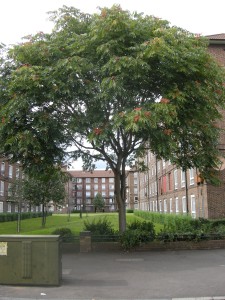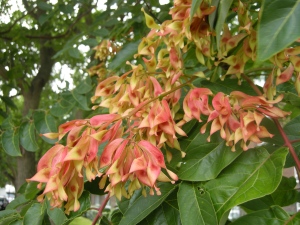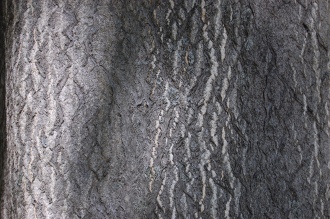Position: Full sun
Soil: Moist, loamy soil
Flowering period: Summer
Eventual Height: 25m
Eventual Spread: 15m
Hardiness: 4a, 4b, 5a, 5b, 6a, 6b, 7a, 7b, 8a, 8b, 9a
Family: Simaroubaceae
Ailanthus altissima is a fast growing, short lived medium sized deciduous tree. All parts of the tree have a distinctive odor. The bark is smooth, light grey becoming rough with age. Its leaves are large, pinnate, arranged alternately on the stem and are dark green on the upper side and white green on the under. The leaves turn a golden red colour in autumn. The dioecious flowers are small and appear in large panicles, are yellow green to reddish in colour and appear in May. The male flowers emit an unpleasant odor to attract pollinating insects. The seeds then mature on the female tree and each are encapsulated in a 2.5cm long samara which appear in July and August. These may remain on the tree until the following spring.
Ailanthus altissima, commonly known as the Tree of Heaven, Ailanthus or Chouchun (in Chinese), is native to north east and central China and Taiwan. The tree was introduced into Europe by Jesuit Pierre Nicholas D’Incarville in the 1740’s. There then followed nearly two centuries of confusion over the naming of this tree until finally is was named Ailanthus altissima in 1957 by Walter T. Swingle. This tree has naturalised across much of Europe. It is considdered an invasive weed in a significant number of countries throughout the world. The tree produces a chemical called ailanthone which suppresses the growth of other plants in its proximity.
The name Ailanthus is from the Moluccan name ailanto meaning sky tree. Altissima is from the Latin meaning ‘tallest’.
The landscape architect may find Ailanthus altissima useful as a fast growing medium sized parkland tree with interesting leaves, bark and samara. It has also been used to re-vegetate areas where acid mine drainage has occurred. It is useful for its drought and pollution tolerant properties but care should be taken when locating this tree as it will not tolerate flooding or deep shade. Care should also be taken when locating this tree as it may cause damage to subterranean drainage pipes. This tree often suckers from the base.
Ailanthus altissima will tolerate almost any soil conditions; it will be happy in neutral, alkaline or acid pH levels. It will thrive in loam, or sand based soils and will grow in nutrient poor soils.
Ecologically, Ailanthus altissima will attract lepidoptera which utilise its foliage as a food source. Bees are attracted to this tree for its pollen.
Ailanthus altissima requires little to no maintenance. Dead or damaged material may be removed in late winter to early spring. Suckers from the base should be removed in early spring.









